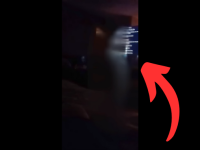These famous false alarms could have ended in tragedy. In this day and age, there are dozens of ways to learn about emergencies. While the breakneck pace at which these alarms are sounded can be the difference between life and death, in some situations the speed of these systems leads to potentially dangerous false alarms. Below, read about some of these unfortunate instances.
10. Famous False Alarms: HD 164595
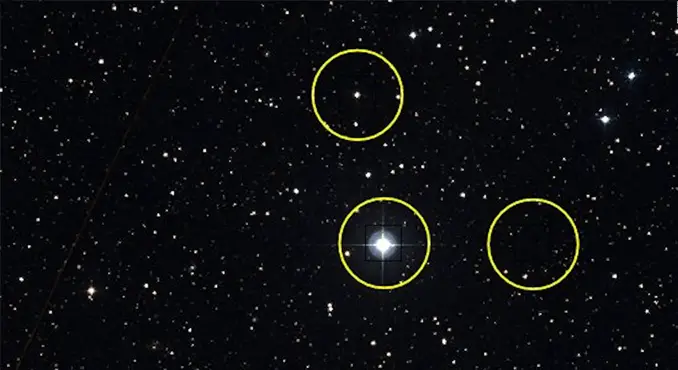
Ever since humans started looking toward the stars, we have speculated about what other life forms may be living in other galaxies. With the advent of more modern technology, scientists are able to monitor signals coming from other planets, hoping to someday make contact from citizens of other worlds.
However, on May 15, 2015, these signal observations led to one of the more bizarre false alarms in recent history. A Russian radio observatory picked up a 2-second signal coming from a planet orbiting a star known as HD 164595. This particular star has a lot in common with Earth’s sun, so this signal recording led many to speculate that the planet contained intelligent life.
Believers in alien life were understandably excited about the discovery. Many media outlets picked up the story, and word quickly spread that the Russian scientists may have at long last discovered an alien species. However, the Russian Academy of the Sciences later issued a statement declaring the alien discovery a false alarm.
9. Famous False Alarms: The War of the Worlds
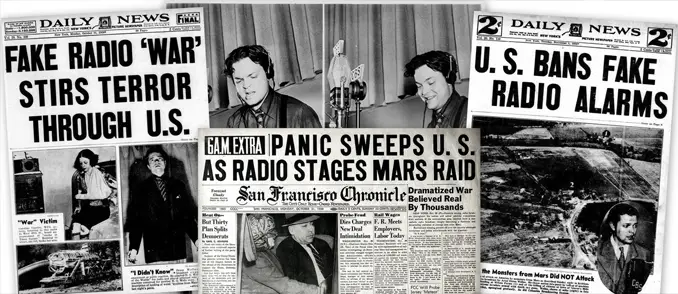
The War of the Worlds may not have been part of a legitimate emergency alert system, but the stir that it caused quickly led to a real-life emergency that made it one of history’s most notorious false alarms.
On October 30, 1938, Orson Welles performed a fictional radio broadcast that appeared to warn viewers of an alien invasion. The “news reporter” cut into a program of dance music to provide updates on the aliens trying to take over New York City.
Although this was intended to be an entertaining broadcast, many viewers didn’t realize that they were listening to a work of fiction. With a second world war looming, American citizens were on high alert, and the broadcast hit too close to home. Many people panicked, and radio stations were ordered to interrupt the broadcast to remind listeners that the content of the show was fictional. However, it was too late to avoid a genuine panic.
8. Famous False Alarms: Zombie Alert
BREAKING: Lake Worth falsely sends out ‘zombie’ alert during power outage https://t.co/LJOVesWFVU pic.twitter.com/7D5HPQovga
— The Palm Beach Post (@pbpost) May 21, 2018
In the cases of HD 164595 and War of the Worlds, the false alarms can be explained by the general public’s false assumptions. However, in the case of Florida’s mistaken zombie alert, it is much more understandable that members of the public thought they were under attack.
On May 20, 2018, Lake Worth, Florida experienced a widespread power outage. The city’s emergency alert system sent out a text message informing citizens of the problem. However, the public was surprised by the text of the alert: “Power outage and zombie alert for residents of Lake Worth and Terminus. There are now far less than seven thousand three hundred and eighty customers involved due to extreme zombie activity.”
It is interesting to note that while Lake Worth was actually experiencing a power outage, Terminus is not really a city in Florida; it is a fictional town from the popular zombie television show, The Walking Dead.
Officials quickly sent out a correction to assure citizens that the messages were false alarms; at least, the part about zombies was false. However, this didn’t stop many members of the public from believing that the government was actually covering up knowledge of real-life zombies. The officials responsible for the message were unable to explain this bizarre broadcast signal intrusion.
7. Hawaii Missile Warning
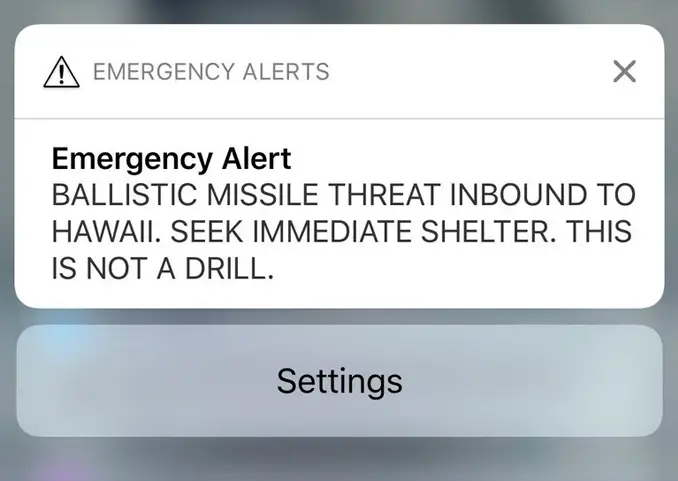
While some false alarms revolve around more fantastical scenarios, others warn of emergencies that are much closer to reality. One example of such a terrifying false alarm occurred in Hawaii in 2018.
Citizens and visitors to the island state were shocked when they received an emergency alert informing them that a ballistic missile was en route to their location. Disturbed by the warning (and its startling parallel to the World War II attacks on Pearl Harbor) residents and tourists quickly began to panic. Businesses rapidly locked their doors and people ran for shelter in any place that they believed was safe, including manholes. Numerous car accidents were reported as drivers took to the streets at high speeds in frantic attempts to reach safe locations. It was reported that one man suffered a heart attack after calling his children to say goodbye.
People panicked for a staggering 38 minutes before the false alarm was corrected. According to employees of the emergency management agency, the alert was supposed to be a test of the system, but someone chose the wrong option on a drop-down menu when issuing the alert.
6. 1971 Emergency Broadcast System Alert
On February 20, 1971, most people were well aware of the dangers being posed by the Cold War. In fact, it was the Cold War’s threat of nuclear annihilation that led the United States to develop its emergency broadcast system. However, the system was only actually used once during the Cold War, and it turned out to be one of history’s scariest false alarms.
News stations received a message over telex reading “This is an Emergency Action Notification directed by the president. Normal broadcasting will cease immediately.” The messages included the code word “hatefulness.” The entire system operated on a system of code words that news stations were to use to verify the messages. “Hatefulness” meant it was the real deal.
Newscasters took to the air to inform the public of the alert. The country waited for the president to come on the air with additional details. Meanwhile, news stations were receiving confusing messages declaring the alerts false alarms. However, none included the correct codeword: “impish.” Finally, after 30 minutes of tense waiting, the system put through official messages including the cancellation codeword, officially making the alert a false alarm.
5. The Boland Hall Fire

The fire that occurred at Bolland Hall at Seton Hall University in South Orange, New Jersey is a disturbing example of the real danger of false alarms. In this case, the fire alarms that went off at 4:30 am on January 19, 2000 were all too real. Two students had set the fire in the dormitory as a prank when most of the students in the building were asleep.
While the fire alarms went off exactly as they should have, the majority of the students in the building remained in their rooms, ignoring the alarms. Why? Over the previous few years, the dormitory had experienced frequent false alarms, so the students in the building assumed this was just another mistake. Because the students assumed it was a false alarm, three residents of the building ended up dying in the fire.
4. The Intruding Bear
The Cold War was a time when false alarms were rampant. However, some caused enough of a stir to be remembered by the history books as truly dangerous situations.
On October 22, 1962, not long after missile silos were discovered being built in Cuba, US interceptors carrying nuclear weapons were sent to small airfields around the country. On October 25, an airman at one of these airfields saw a shadowy figure outside of a fence. Thinking it was enemy sabotage, he sounded the intruder alarm. This caused a nearby base to be alarmed suggesting they were under attack. Pilots ran to their planes to start scouring the skies for enemy crafts. They later learned that it was a false alarm.
It wasn’t until years later that the pilots learned the truth about one of the most bizarre false alarms in history. It turned out that the mysterious intruder spotted outside the base was actually a bear.
3. Harold Camping

Over the years, there have been numerous theories about the end of the world. These days, most people take these prophecies with a grain of salt, but that wasn’t always the case. Harold Camping, a popular Christian radio personality, predicted that the world would end on May 21, 2011. He supported his hypothesis with calculations he said came from the Bible. He claimed that certain faithful followers would be raptured to heaven, while everyone else would have to live through horrible end times.
Camping’s followers were told to gather together at a meeting point where they could ascend to heaven. Many of the faithful sold their possessions to afford the journey. The date came and went without incident. Camping’s prediction was a false alarm.
His followers were devastated. Many were left destitute after spending so much money in the hopes of a rapture. Even more shocking is that before the supposed end of the world, there was at least one reported suicide committed by a devastated woman who believed she wouldn’t make it to heaven.
2. Submarine B-59
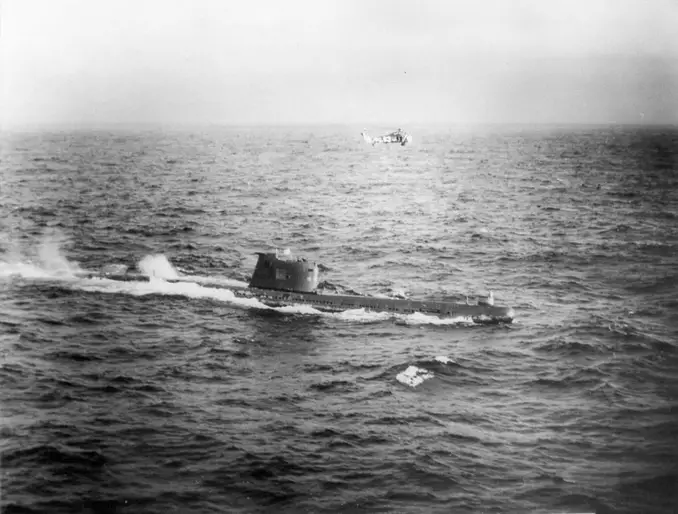
On October 1, 1962, during the height of the Cold War, a Soviet submarine left its base to sail into the Caribbean. Several weeks later, on October 27, United States Naval ships detected the Soviet craft. They began sending out small charges to the submarine, intending to force the craft to the surface so they could identify it.
However, what the US ships didn’t know is that the Soviet submarine had been out of contact with its base and was too deep to listen to radio signals. The captain believed that the charges from the US ship were an indication that the US and Soviet Union had begun a war in the time he had been out of contact. He wanted to launch torpedoes at the US ship, an act that likely would have been considered an act of war.
Thankfully, the other commanding officers on the ship refused to launch any torpedos. They convinced the captain to go to the surface and await further orders. When the submarine surfaced and saw the nearby US ships, the captain decided to return to Moscow instead of engaging, an act that may have prevented an all-out war between the nations.
1. Stanislav Petrov

Not all of the Cold War false alarms that nearly led to nuclear war occurred as far back in history as we would like to believe. In 1983, the actions of a single man prevented catastrophe.
Stanislav Petrov worked at a nuclear early-warning station in Russia. On September 26, 1983, he received a report that as many as six nuclear missiles had been launched from the United States. Soviet military protocol at the time required such reports to be forwarded to commanding officers. However, Petrov believed these reports to be false alarms, as so many missiles at once seemed unlikely. He feared that if he reported them to his commanding officers, they would retaliate anyway, launching a true nuclear war.
He made the quick decision not to report the warning. As it turned out, he was correct. The warning came as a result of a computer malfunction. Petrov’s quick thinking and willingness to disobey protocol may have saved the world from disaster.




